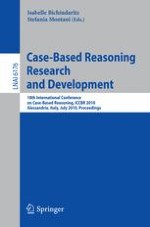2010 | Buch
Case-Based Reasoning. Research and Development
18th International Conference on Case-Based Reasoning, ICCBR 2010, Alessandria, Italy, July 19-22, 2010. Proceedings
herausgegeben von: Isabelle Bichindaritz, Stefania Montani
Verlag: Springer Berlin Heidelberg
Buchreihe : Lecture Notes in Computer Science
